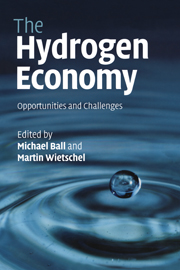Book contents
- Frontmatter
- Contents
- List of main contributors
- Preface
- Acknowledgements
- List of abbreviations
- 1 Scope of the book
- 2 Why hydrogen?
- 3 Non-renewable energy resources: fossil fuels – supply and future availability
- 4 Non-renewable energy resources: nuclear fuels
- 5 Assessment of the potentials for renewable energy sources
- 6 Carbon capture and storage
- 7 Energy-chain analysis of hydrogen and its competing alternative fuels for transport
- 8 Hydrogen today
- 9 Fundamental properties of hydrogen
- 10 Hydrogen production
- 11 Hydrogen storage
- 12 Hydrogen distribution
- 13 Key role of fuel cells
- 14 Hydrogen-infrastructure build-up in Europe
- 15 Building a hydrogen infrastructure in the USA
- 16 Hydrogen and the electricity sector
- 17 Hydrogen corridors
- 18 Macroeconomic impacts of hydrogen
- 19 Sustainable transport visions: the role of hydrogen and fuel-cell vehicle technologies
- 20 Energy-efficient solutions needed – paving the way for hydrogen
- 21 The future of hydrogen – opportunities and challenges
- Further reading
- Index
- References
14 - Hydrogen-infrastructure build-up in Europe
Published online by Cambridge University Press: 22 January 2010
- Frontmatter
- Contents
- List of main contributors
- Preface
- Acknowledgements
- List of abbreviations
- 1 Scope of the book
- 2 Why hydrogen?
- 3 Non-renewable energy resources: fossil fuels – supply and future availability
- 4 Non-renewable energy resources: nuclear fuels
- 5 Assessment of the potentials for renewable energy sources
- 6 Carbon capture and storage
- 7 Energy-chain analysis of hydrogen and its competing alternative fuels for transport
- 8 Hydrogen today
- 9 Fundamental properties of hydrogen
- 10 Hydrogen production
- 11 Hydrogen storage
- 12 Hydrogen distribution
- 13 Key role of fuel cells
- 14 Hydrogen-infrastructure build-up in Europe
- 15 Building a hydrogen infrastructure in the USA
- 16 Hydrogen and the electricity sector
- 17 Hydrogen corridors
- 18 Macroeconomic impacts of hydrogen
- 19 Sustainable transport visions: the role of hydrogen and fuel-cell vehicle technologies
- 20 Energy-efficient solutions needed – paving the way for hydrogen
- 21 The future of hydrogen – opportunities and challenges
- Further reading
- Index
- References
Summary
If a mass-market roll-out of hydrogen vehicles in the European Union takes place in the next 10 to 15 years, as promoted by the European Hydrogen and Fuel Cell Technology Platform (HFP), then infrastructure strategies will be crucial. At the core of any infrastructure analysis is the question of how the infrastructure should be developed over time and how the needs of both consumers and suppliers can be met. At the same time, such an analysis must also take into account the characteristics of different national energy systems (such as the availability of primary energy sources or competition for end uses), as well as national energy policies. What this infrastructure build-up could look like and what it might cost is shown in a case study for Germany as well as at the European level. On this basis, more general infrastructure strategies are derived with respect to roll-out strategies, production mix and distribution options, and their impacts on supply costs and CO2 emissions. The chapter finishes with an outlook on global hydrogen scenarios.
The need for a hydrogen-infrastructure analysis
The potential benefits of a hydrogen economy are recognised to differing degrees by national governments and supranational institutions, although the pathways and timeframes to achieve such a transition remain highly contended. The development of hydrogen-powered fuel-cell vehicles that are economically and technologically competitive with conventional vehicles is a crucial prerequisite for the successful introduction of hydrogen as an automotive fuel.
- Type
- Chapter
- Information
- The Hydrogen EconomyOpportunities and Challenges, pp. 385 - 453Publisher: Cambridge University PressPrint publication year: 2009
References
- 2
- Cited by



